|
|
|
Sort Order |
|
|
|
Items / Page
|
|
|
|
|
|
|
| Srl | Item |
| 1 |
ID:
130269
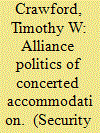

|
|
|
|
|
| Publication |
2014.
|
| Summary/Abstract |
This article examines the challenges allies face in coordinating diplomatic efforts to accommodate and peel off their main enemy's Potential Allies. It elucidates the key dimensions, and the underlying Coordination Dynamics, of this problem of "concerted accommodation," and it develops propositions about the conditions that shape the efficacy of such efforts. The argument links allies' strength to their divergent or convergent assessments of the target state's ability to tip the war toward victory or defeat. Divergent assessments foster weak allied efforts that are likely to fail, but when allies agree that the target is a potential "war-tipper," they will support their concerted accommodation policy with more robust cooperation that is more likely to work. The causal arguments and mechanisms are examined in a paired comparison analysis of two First World War cases: the Entente's efforts to induce (1) Ottoman neutrality and (2) Italian intervention.
|
|
|
|
|
|
|
|
|
|
|
|
|
|
|
|
| 2 |
ID:
144319
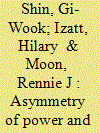

|
|
|
|
|
| Summary/Abstract |
While power asymmetry typically defines security relationships between allies, there exist other forms of asymmetry that influence alliance politics. In order to illustrate how they can shape policy outcomes that cannot be explained solely through the lens of power capabilities, the authors examine the role of relative attention that each side pays to the alliance. It is their central argument that since the client state has a greater vested interest in the alliance and given that attention depends on interest/need, the client state can leverage attention to get its way. By analysing two specific cases, the 2002 South Korean schoolgirls tragedy and the 2008 beef protests—instances where the South Koreans succeeded in compelling US concessions—the authors show that because the alliance was more central to the client state's agendas, there existed an asymmetry of attention that offered leveraging opportunities for the weaker ally. In this study, the authors emphasise the role of media attention as a key variable, and seek to contribute to debates on weaker party leverage in asymmetrical alliances.
|
|
|
|
|
|
|
|
|
|
|
|
|
|
|
|
| 3 |
ID:
158689
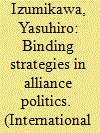

|
|
|
|
|
| Summary/Abstract |
In the mid-1950s, the Soviet Union used a wedge strategy aimed at weaning Japan away from the United States. While the effort failed, this was far from an inevitable outcome. At the time, the Japanese government publicly expressed its intention to improve relations with the communist bloc. Moreover, Moscow offered Tokyo attractive carrots, mainly in the form of a favorable resolution of outstanding territorial disputes. I argue that the failure stemmed from how the United States deployed binding strategies—policies aimed at maintaining or enhancing an ally's loyalty—to counter Moscow's overtures. In doing so, I seek to expand our understanding of binding strategies and the dynamic interplay between binding and wedge strategies. To this end, I present a typology of binding strategies and develop a theory that encompasses dynamic interactions between binding and wedge strategies. I then test the theory with the case of the Soviet-Japanese-US triangular diplomacy and demonstrate that the two strategies are deeply intertwined and should be analyzed as such. I conclude by discussing broader theoretical implications, such as the possibility of developing a dynamic theory of alliance politics.
|
|
|
|
|
|
|
|
|
|
|
|
|
|
|
|
| 4 |
ID:
082805
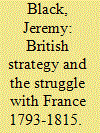

|
|
|
|
|
| Publication |
2008.
|
| Summary/Abstract |
This article examines the various constraints under which the conduct of British strategy operated during the French Wars - examples include its political and geographical situation, its far-flung colonial interests and its limited military resources and its need to maintain a strong alliance system in continental Europe - and shows how the direction that it took closely mirrored a variety of campaigns in the eighteenth century. That said, the position in which Britain found herself in the struggle against the French Revolution and Napoleon was frequently contradictory, and it is no coincidence that it was some time before the ideal combination of strategies was found that marked the period 1808-14. The fact that the difficulties involved were overcome said a great deal for the underlying strength of the British state.
|
|
|
|
|
|
|
|
|
|
|
|
|
|
|
|
| 5 |
ID:
121587


|
|
|
|
|
| Publication |
2012.
|
| Summary/Abstract |
The substantial literature on mass violence, from ethnic cleansing to civil wars, has paid surprisingly little attention to the largest instance of mass violence in human history: the Holocaust. When political scientists have approached the subject, the trend has been to treat the Holocaust as a single case, comparing it-sometimes controversially-with other instances of genocide such as Rwanda or Cambodia. But historically grounded work on the destruction of European Jewry can help illuminate the microfoundations of violent politics, unpack the relationship between a ubiquitous violence-inducing ideology (antisemitism) and highly variable murder, and recast old questions about the origins and evolution of the Holocaust itself. After reviewing new trends in history-writing, I highlight opportunities for social-scientifically oriented research centered on the interaction of state power, local communities, and violent mobilization in five areas: military occupation, repertoires of violence, alliance politics, genocidal policymaking, and resistance. My conclusion addresses thorny issues of comparison, morality, and memory.
|
|
|
|
|
|
|
|
|
|
|
|
|
|
|
|
| 6 |
ID:
115194
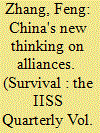

|
|
|
|
|
| Publication |
2012.
|
| Summary/Abstract |
In December 1949, Mao Zedong, paramount leader of the newly founded People's Republic of China, travelled to Moscow to negotiate a military alliance with the Soviet Union. Within barely two decades, however, not only had the alliance collapsed, but the two former allies had become bitter ideological and military adversaries. Strategic exigencies compelled the Chinese leadership to seek rapprochement with the United States, producing a quasi-alliance between the two erstwhile enemies after 1972. In January 1979, during his visit to Washington, Deng Xiaoping sought to nudge the United States toward developing a de facto, if informal, alliance with China in order to secure American support for China's impending invasion of Vietnam. During the last decade of the Cold War, China and the United States also maintained a degree of strategic cooperation against the Soviet Union.
|
|
|
|
|
|
|
|
|
|
|
|
|
|
|
|
| 7 |
ID:
154815


|
|
|
|
|
| Summary/Abstract |
This article argues that the perceived need by NATO to nurture political cohesion within the Alliance during the 1950s resulted in the adoption of strategic concepts that were out-of-step with the military environment in which it was operating. It maintains that the Alliance acquiesced to American leadership on nuclear issues which led to the development of tactical nuclear capabilities at the expense of conventional war-fighting capabilities for the defence of the European Central Front. This resulted in a strategic concept that enhanced political cohesion but was militarily unviable.
|
|
|
|
|
|
|
|
|
|
|
|
|
|
|
|
| 8 |
ID:
175662
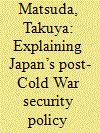

|
|
|
|
|
| Summary/Abstract |
Why has Japan shifted towards a more active security posture since the end of the Cold War? Japan’s security policy under Prime Minister Abe has triggered numerous discussions on the changing nature of Japan as a security actor. This article identifies two independent variables—the balance of power calculations and secure access to the maritime commons—that informs Japan’s security policy trajectory. It argues that Japanese strategy is best described as ‘maritime realism’, a posture in which liberal internationalist and realist elements draw upon principles of maritime strategy to fuse together. Japan has not only actively facilitated US commitment to maritime Asia but also focused on expanding its role in maritime security as the maritime space in the Indo-Pacific has increasingly become a contested space. While Tokyo’s security policy corresponds with structural realist predictions, they have also been frequently expressed in liberal internationalist language given the peculiar nature of the role of navies. This article’s findings advance theoretical debates on alliance politics and great power competition by integrating international relations and concepts in strategic studies. It also contains significant explanatory power in assessing the trajectory of Japan’s defence policy since the end of the Cold War.
|
|
|
|
|
|
|
|
|
|
|
|
|
|
|
|
| 9 |
ID:
072547
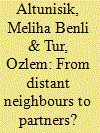

|
|
|
|
|
| Publication |
2006.
|
| Summary/Abstract |
The growth of cooperative relations between Syria and Turkey, after the two countries came to the brink of war in 1998, has been a major development in the Middle East. This article examines both the reasons behind increasing ties between the two countries and the new challenges this rapprochement is facing due to the rapidly shifting international context. It argues that although systemic factors have been crucial in setting up the parameters of the bilateral relationship, these factors gain meaning through the complexities of domestic settings. The US policy of regime change and the Iraq War of 2003 and its aftermath are taken as the main regional and international factors influencing relations between the two countries since 1998. Domestic factors like the process of regime consolidation in Syria under Bashar and rising nationalism, the Kurdish issue, and the coming to power of the Justice and Development Party in Turkey constitute the main lenses through which these systemic factors are evaluated and policy outcomes projected.
|
|
|
|
|
|
|
|
|
|
|
|
|
|
|
|
| 10 |
ID:
158004
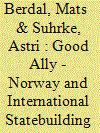

|
|
|
|
|
| Summary/Abstract |
The article examines the findings of the Commission of Inquiry established by the Norwegian government in 2014 to evaluate all aspects of Norway’s civilian and military contribution to the international operation in Afghanistan from 2001 to 2014. Concerned with the wider implications of the Commission’s findings, it focuses on two issues in particular: (1) Norway’s relations with the US, a close and long-standing strategic ally whose resources, capabilities and dominance of decision-making dwarfed that of all other coalition partners in Afghanistan; and (2) Norway’s record in the province of Faryab, where, from 2005 to 2012, a Norwegian-led Provincial Reconstruction Team was charged with bringing security, good governance and development to the province. How Norway prioritised and managed relations with the US highlights and helps to problematise the challenges – political, practical and moral – facing small and medium-sized powers operating in a coalition alongside the US. Norwegian efforts in Faryab are revealing of the dilemmas and contradictions that plagued and, ultimately, fatally undermined the international intervention as a whole. As such, Norway’s experience provides a microcosm through which the inherent limitations of the attempt to transfer the structures of modern statehood and Western democracy to Afghanistan can be better understood.
|
|
|
|
|
|
|
|
|
|
|
|
|
|
|
|
| 11 |
ID:
147847
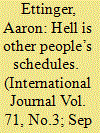

|
|
|
|
|
| Summary/Abstract |
Since 2001, Canada has participated in multilateral security operations in Afghanistan and Libya, and as part of the anti-ISIS coalition. Canada’s contributions have been the sum of eleven distinct time-delimited missions ranging from six months to four years. Until now, this variation in strategic duration has drawn little scholarly attention. This paper investigates the logic underpinning Canada’s variable mission commitments. We find that the actions of specific allies, as well as the NATO alliance as a whole, can account for the particular duration of Canadian military commitments. External pressure, combined with Canada’s internationalist orientation, reputational concerns, and the relative weakness of Canada’s Parliament, contributes to a cycle of engagement and re-engagement whereby extrication is perceived to come with high costs in reputation. This creates a dilemma for Canadian governments: participate in multilateral operations and be seen as a good ally, but cede control over strategic duration to forces beyond your control; or, don’t participate and risk that standing.
|
|
|
|
|
|
|
|
|
|
|
|
|
|
|
|
| 12 |
ID:
186542
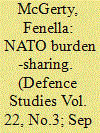

|
|
|
|
|
| Summary/Abstract |
How can NATO upgrade its understanding of (and metrics for) fair burden-sharing? Alliance burden-sharing is a lasting concern for the North Atlantic Treaty Organization (NATO) and will remain a focal point of the NATO 2022 Strategic Concept. Public discussions of NATO burden-sharing and the 2014 Defense Investment Pledge overemphasize defense expenditure and fail to account for alternative frameworks for understanding alliance burden-sharing and specifically, NATO’s optimal burden-share distribution. The U.S. Military Academy’s February 2022 NATO Strategic Concept Seminar featured a panel on burden-sharing frameworks and metrics. In this article, we present the main ideas and arguments, placed within the existing literature on alliance burden-sharing. We argue that, in the long-run, NATO can develop more fair, effective, and efficient burden-sharing arrangements by encouraging weapons and capability specialization, increasing inexpensive but influential operations such as advisory missions, and adapting flexible command and control structures when partnering with non-NATO actors on future battlefields. We argue that, in the short-run, NATO can refine the Defense Investment Pledge with a balanced focus on Cash, Capabilities, and Contributions while also extending the deadline for complete compliance with existing expenditure benchmarks until 2030.
|
|
|
|
|
|
|
|
|
|
|
|
|
|
|
|
| 13 |
ID:
116432
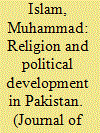

|
|
|
| 14 |
ID:
080910
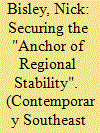

|
|
|
|
|
| Publication |
2008.
|
| Summary/Abstract |
Over the past decade, the US-Japan alliance has been strengthened and subtly but substantively transformed. In response to a range of domestic changes and new international challenges, a relationship that was becoming frayed in the immediate aftermath of the Cold War has been rejuvenated and re-tooled with significant consequences for East Asia's strategic setting. This article provides a critical analysis of this process with two ends in mind. First, it provides a systematic overview of the changes, their sources and what they mean for the alliance partners and their security interests. It argues that the US-Japan alliance now has two distinct functions, one relating to regional stability and the other focusing on shared global strategic aims. The alliance is in good health, but its continued vitality will require careful management. Second, it assesses the regional consequences of this change and argues that while alliance enhancement has been intended to promote mutual and regional security there is reason to doubt whether the latter goal has been served through the enhancement process
|
|
|
|
|
|
|
|
|
|
|
|
|
|
|
|
| 15 |
ID:
137505
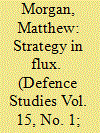

|
|
|
|
|
| Summary/Abstract |
In response to the uncertain geopolitical environment which confronted it after the end of the Cold War, NATO adopted a strategy of risk management. Two institutions – the Science and Technology Office and Allied Command Transformation – were responsible for translating this policy into practice. By promoting knowledge development, each institution sought to make NATO a more reflexive and responsive organization. Knowledge development became the foundation for a new model of command and control created by two Science and Technology Office working groups. While this model has vast potential, its implementation has been blocked by internal rifts within NATO.
|
|
|
|
|
|
|
|
|
|
|
|
|
|
|
|
| 16 |
ID:
137938
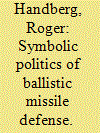

|
|
|
|
|
| Summary/Abstract |
Ballistic missile defense (BMD) politics present an interesting evolution in how the USA, especially Congress, has come to think about BMD both as operational reality and as a symbolic policy. The argument here is that BMD’s operational reality is increasingly overshadowed by its symbolic aspects. Such a status arose from rapidly changing international and domestic politics. The end result is a situation in which BMD policy in a sense floats above the question of its actual combat effectiveness. Its primary mission in part is sustaining US capacity to remain a global power and support its allies.
|
|
|
|
|
|
|
|
|
|
|
|
|
|
|
|
| 17 |
ID:
103095
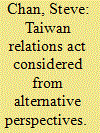

|
|
|
| 18 |
ID:
126710
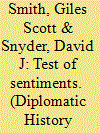

|
|
|
|
|
| Publication |
2013.
|
| Summary/Abstract |
For the best part of three decades, from 1946 until 1977, civil aviation played a central role in Dutch-American diplomatic relations, consistently causing major friction at the highest levels of both the government and the business sector on both sides of the Atlantic. Yet up till now this remarkable episode in the relations between two close transatlantic allies has remained under-researched and neglected by traditional diplomatic historians unable to grasp its full significance. The dispute centered on the ostensibly anodyne wish of the Dutch national airline, KLM, to expand its access to airports in the United States. Yet the "landing rights question" exposed more than ever the uneven power relations, clashing national interests, and antagonistic perceptions that lay behind the otherwise friendly relations between Washington and The Hague. The article examines the causes and consequences of these tensions through four intense periods of negotiations in the 1940s, 1950s, 1960s, and 1970s, each case involving a set of actors, interests, and strategies. On the U.S. side, the divergence between diplomatic and commercial interests lay at the heart of a hard-nosed civil aviation policy that was not prepared to give the Dutch what they wanted. Meanwhile for the Dutch, KLM represented the epitome of national pride and pioneering enterprise, and U.S. intransigence on the landing rights issue was regarded as hypocritical and a direct threat to the continuing vitality of the airline itself. Looking to overcome this asymmetric deficit, the Dutch employed various strategies-public diplomacy, the contacts of elite networks, the "rights" of a close ally-to secure results. Coming from the perspective of "New Diplomatic History," the article maintains that traditional state-centered historiography tends to miss the deeper terrain on which bilateral and multilateral relations among the western allies were conducted. As a result, it provides a behind-the-scenes view of alliance politics from a unique angle during the Cold War.
|
|
|
|
|
|
|
|
|
|
|
|
|
|
|
|
| 19 |
ID:
123397
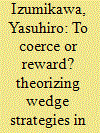

|
|
|
|
|
| Publication |
2013.
|
| Summary/Abstract |
Wedge strategy, a policy of preventing or dividing an adversary coalition, has been attracting increasing scholarly attention. In particular, Timothy Crawford has articulated the concept and claims that reward-based strategies are more effective than coercive strategies that actually strengthen the ties between enemies. Although this sounds logical, history provides sufficient cases that contradict the claim. Why? To answer the question, I develop a theory of wedge strategy by utilizing the concept of reward power. I then argue that although countries seeking to divide adversary coalitions usually prefer reward-based strategies, they turn to coercive measures when a divider state perceives grave threats as a result of a target state's strong alignment with its primary enemy but does not have sufficient reward power to split the adversaries. I examine this theory through two case studies of us wedge strategies toward the Sino-Soviet alliance during the early Cold War period. This article addresses the specific puzzle of choices between reward and coercive wedge strategies and offers broader theoretical implications regarding the utility of the concept of reward power in international and alliance politics.
|
|
|
|
|
|
|
|
|
|
|
|
|
|
|
|
|
|
|
|
|